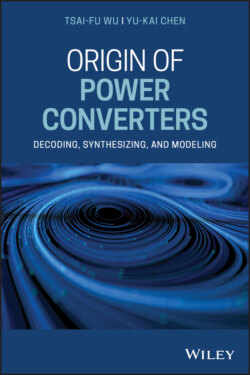Читать книгу Origin of Power Converters - Tsai-Fu Wu - Страница 33
2.2.2 CCM Operation
ОглавлениеA buck converter and its voltage transfer ratio under CCM operation are shown in Figure 2.6a. When taking the output from capacitor C1, we can have the following voltage transfer ratio:
(2.6)
If taking the output from capacitor C2, we will have a transfer ratio of
(2.7)
The voltage transfer ratio of a buck‐boost converter is
(2.8)
and it can be decoded into the form shown in Figure 2.6b, in which the forward‐path gain is D and the feedback‐path gain is unity. The gain D can be synthesized with a buck converter for its single‐ended characteristic and meeting the requirement of a forward path in a control system with forward and feedback paths. The unity‐gain feedback is synthesized by feeding back the output voltage Vo to the input, and there is no power flow from this feedback path to the output. Thus, the overall converter configuration depicted in Figure 2.6c can synthesize the control block diagram shown in Figure 2.6b satisfactorily and correctly. Redrawing the circuit shown in Figure 2.6c yields the buck‐boost converter, as shown in Figure 2.6d, which is in the form that people are familiar with.
Figure 2.6 Decoding, synthesizing, and evolution of buck‐boost and boost converters from the buck converter.
Similarly, we can take the output from capacitor C2 of the buck‐boost converter depicted in Figure 2.6d, and we have the following voltage transfer ratio or code:
(2.9)
which is the input–output voltage transfer ratio or code of the boost converter in CCM operation. Redrawing the circuit of Figure 2.6d yields the one shown in Figure 2.6e, in which voltages Vi, Vo, and form a loop and one of the voltages is a dependent variable. Since we do not take output from capacitor C1, it can be removed from the circuit, as shown in Figure 2.6f. When moving inductor L1 and diode D1 from the return path to the forward, we can obtain the boost converter, as shown in Figure 2.6g. With the decoding and synthesizing processes, the buck‐boost and boost converters can be evolved from the buck converter. Thus, the buck converter can be considered preliminarily the origin of power converters.
